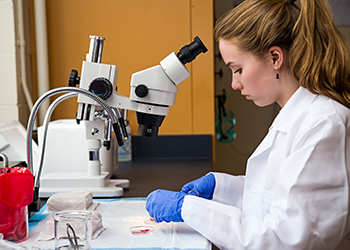Dr. David Baker's Research
Probing Outside of the Synapse: Contribution of Extrasynaptic Glutamate to Neuropsychiatric Disorders
Glutamate represents the primary excitatory neurotransmitter and is involved in most aspects of brain functioning in the normal and diseased states. While synaptically released glutamate has been studied in great detail, a dearth of knowledge exists regarding the contribution of extrasynaptic glutamate release mechanisms, including cystine-glutamate antiporters (also referred to as system xc-), to pathological conditions involving glutamate dysfunction. The focus of my research is to determine whether extrasynaptic release mechanisms represent unrecognized targets in unmasking the etiology and treatment of psychiatric disorders.
We utilize a pathophysiological approach whereby the involvement of extrasynaptic release mechanisms in neuropsychiatric disorders is examined using preclinical models of schizophrenia and cocaine addiction. Currently, we are examining a) how cocaine and manipulations thought to model schizophrenia result in diminished glutamate release from system xc-, b) the impact of reduced system xc- activity on brain functioning in the normal and pathological states, and c) the potential for increased cystine-glutamate exchange following administration of cysteine prodrugs to reverse behaviors used to model aspects of these diseases as well as the symptoms of the disease in humans. To do this, the laboratory incorporates a number of molecular, neurochemical, and behavioral techniques to address these questions and collaborates with a number of external laboratories.
In addition to our research program, we have initiated a medication development program both within the laboratory at Marquette University and within a company recently cofounded by Drs. David Baker and John Mantsch (Promentis Pharmaceuticals, Inc.). Funding for our academic and commercial endeavors is provided by private investors as well as grants from the National Institute on Drug Abuse, National Institute of Mental Health, the State of Wisconsin, and the National Alliance for Research on Schizophrenia and Depression.
Selected Publications
- Bridges R, Lobner D, Baker DA, Thinking outside the cleft to understand the synapse: Contribution of system xc- to normal and pathological glutamatergic signaling, invited review by Pharmacological Reviews.
- Blacktop J, Seubert C, Baker DA, Ferda N, Lee G, Graf EN, Mantsch JR (2011) Augmented cocaine seeking in response to stress or CRF delivered into the ventral tegmental area following long-access self-administration is mediated by CRF-R1 but not CRF-R2 receptors. J Neuroscience., 31,11396-403.
- Amen S, Piacentine L, Mantsch J, Li SJ, Risinger R, Baker DA (2011) Repeated N-acetylcysteine reduces cocaine seeking in rodents and craving in cocaine-dependent humans, Neuropsychopharmacology, 36, 871-8.
- Graf EN, Hoks MA, Baumgardner J, Sierra J, Vranjkovic O, Bohr C, Baker DA, Mantsch JR (2011) Adrenal activity during repeated long-access cocaine self-administration is required for later CRF-induced and CRF-dependent stressor-induced reinstatement in rats. Neuropsychopharmacology, 36, 1444-1454.
- Figueroa-Guzman Y, Mueller C, Vranjkovic O, Wisniewski S, Yang Z, Li SJ, Bohr C, Graf EN, Baker DA, Mantsch JR (2011) Oral administration of levo-tetrahydropalmatine attenuates reinstatement of extinguished cocaine seeking by cocaine, stress or drug-associated cues in rats. Drug Alcohol Dep, 116, 72-79.
- Madayag A, Kau K, Lobner D, Mantsch JR, Wisniewski S, Baker DA (2010). Drug-induced plasticity contributing to heightened relapse susceptibility: Neurochemical changes and augmented reinstatement in high-intake rats. J. Neuroscience, 30, 210-217.
- Mantsch JR, Weyer A, Vranjkovic O, Beyer CE, Baker DA, Caretta H (2010) Involvement of noradrenergic neurotransmission in the stress- but not cocaine-induced reinstatement of extinguished cocaine-induced conditioned place preference in mice: Role for b-2 adrenergic receptors. Neuropsychopharmacology, 35, 2165-78.
- Mantsch JR, Wisniewski S, Vranjkovic O, Peters C, Becker A, Valentine A, Li SJ, Baker DA, Yang Z (2010) Levo-tetrahydropalmatine attenuates cocaine self-administration under a progressive-ratio schedule and cocaine discrimination in rats. Pharmacol., Biochem., Behav. 97, 310-316.
- Kau K, Madayag A, Mantsch JR, Grier MD, Abdulhameed O, Baker DA (2008) Blunted system xc- in the nucleus accumbens promotes cocaine-induced drug seeking. Neuroscience, 155, 530-557.
- Baker DA, Madayag A, Meador-Woodruff JH, Kristiansen L, Haroutunian V, Raju I (2008) Contribution of cystine-glutamate antiporter to the psychotomimetic effects of phencyclidine, Neuropsychopharmacology, 33, 1760-1772.
- Mantsch JR, Baker DA, Francis DM, Katz ES, Hoks MA, Serge JP (2008) Stressor- and corticotropin releasing factor-induced reinstatement and active stress-related behavioral responses are augmented following long-access cocaine self-administration by rats. Psychopharmacology, 195, 591-603.
- Mantsch JR, Baker DA, Serge JP, Hoks MA, Francis DM, Katz ES (2008) Surgical adrenalectomy with diurnal corticosterone replacement slows escalation and prevents the augmentation of cocaine-induced reinstatement in rats self-administering cocaine under long-access conditions. Neuropsychopharmacology, 33, 814-26.
- Madayag A, Lobner D, Kau K, Mantsch J, Abdulhameed O, Hearing M, Grier M, Baker DA (2007) Repeated N-Acetylcysteine administration alters plasticity-dependent effects of cocaine. J. Neuroscience 27, 13968-13976.
- Mantsch JR, Cullinan WE, Tang LC, Baker DA, Katz ES, Hoks MA, Ziegler DR (2007) Daily cocaine self-administration under long-access conditions augments restraint-induced increases in plasma corticosterone and impairs glucocorticoid receptor-mediated negative feedback in rats. Brain Research, 1167, 101-111.
- Mantsch JR, Li SJ, Risinger R, Awad S, Katz E, Baker DA, Yang Z (2007) Levo-tetrahydropalmatine attenuates cocaine self-administration and cocaine-induced reinstatement in rats. Psychopharmacology, 192, 581-91.
- Baker DA, McFarland K, Lake RW, Shen H, Toda S, Kalivas PW (2003) Neuroadaptations in cystine-glutamate exchange underlie cocaine relapse. Nature Neuroscience, 6, 743-749
- Baker DA, Xi ZX, Shen H, Swanson CJ, Kalivas PW (2002) The primary source and neuronal function of in vivo non-synaptic glutamate. J. Neuroscience, 22, 9134-914


